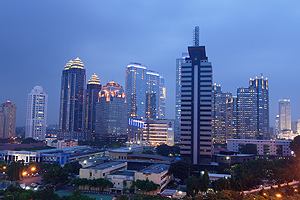
Indonesia’s president-elect Joko Widodo (Jokowi) has declared he aims to push the growth rate of the economy above 7% a year. The growth rate has been running below 6% a year, and the World Bank and IMF predict that it will continue at 5.6% and 5.8%, respectively, in 2015.
The recent slow growth comes at the tail end of the resource boom. The effect of the end of the boom was not felt immediately due to the easy money in global capital markets from quantitative easing in the United States. To keep inflation under control and avoid a balance of payments crisis, Indonesia’s fiscal and monetary authorities have been engineering a slowdown and demand-side consolidation.
Indonesia facing mediocre growth
That a slowdown was necessary when growth is below 6% in an economy at Indonesia’s level of development—and with its young and growing population—points to major structural problems in the economy. Income per capita is $3,500 and the median age is 28 years: a growth rate of below 6% is too low to create jobs for the 2.3 million young people entering the workforce each year. Indonesia needs to cash in on this demographic dividend or face the prospect of mediocre growth and stagnant incomes and remain stuck in neutral, in a middle income trap at the lower bound, for the foreseeable future. As Indonesia has the world’s fourth largest population, the potential implications go beyond a less prosperous Indonesia.
Avoiding the new normal in Indonesian economic growth being below 6% will require a significant supply-side effort to lift productivity by restructuring the economy.
Compared to its neighbors, Indonesia largely remains outside regional production networks and its manufacturing sector does not play a significant role in factory Asia. This is a weakness when faced with lower commodity prices globally and non-resource growth is critical.
Indonesia is attracting more foreign direct investment than ever and is climbing the global rankings as a preferred destination for investing, but that is occurring with little improvement to the investment environment or competitiveness. For example, for the first time ever the Japan Bank of International Cooperation survey of Japanese firms, which started in 1989, Indonesia has been ranked as the most attractive destination for Japanese investment, overtaking the People’s Republic of China (PRC), which has consistently been the highest in recent decades. The main reason appears to be rising wage costs in the PRC. But, to remain an attractive destination for foreign investment, much more needs to be done at home beyond relying on external factors.
Compared with its neighbours (PRC, Malaysia, Philippines, Singapore, Thailand, Viet Nam), Indonesia has the smallest share of manufacturing as a share of its GDP or of total exports. Indonesia is even more of an outlier in parts and components manufacturing as a share of GDP or exports. Indonesia is connected to the lowest-cost suppliers in the region, via multinationals that import from their supply chains to their plants in Indonesia, produce goods, and then sell to the domestic market. But what is absent is a role for Indonesia-based producers as major suppliers to those networks internationally.
Much fuller participation in global supply chains and lifting of the growth potential can be achieved by improving infrastructure, improving the investment environment, and using regional initiatives strategically to make strong commitments that reinforce domestic reform priorities. Being part of production networks allows countries to specialise more and realise their comparative advantages, which is important in generating employment and importing technology, capital, and knowhow.
As a vibrant democracy, Indonesia has at times allowed protectionist and nationalist voices to dominate and make Indonesia appear inward looking. Jokowi needs to turn that around and help the country embrace openness: openness to trade, investment, people, and ideas. The countries around Indonesia that have succeeded in sustaining high growth have done so by integrating into the regional and global economy.
When hosting the 2013 APEC summit, Indonesia championed infrastructure investment. Structural reform and macroeconomic constraints are inhibiting needed infrastructure expansion in Indonesia and throughout the region. Infrastructure spending as a proportion of GDP has not returned to pre-1997 Asian financial crisis levels in Indonesia and the infrastructure deficit has been a major bottleneck to growth.
Need for Indonesia to commit to RCEP and AEC
Also in 2013, Indonesia helped deliver a breakthrough at the WTO Ministerial conference, which helped build momentum for regional and global cooperation. The challenge now will be for Indonesia to commit to, and show leadership in, the Regional Comprehensive Economic Partnership (RCEP) and the implementation of the ASEAN Economic Community (AEC), where there are new opportunities that strongly complement domestic reform priorities.
Many in Asia and beyond will be watching Jokowi as the success of the AEC and RCEP depends on Indonesia. Luckily for Jokowi, strong commitments to the AEC and RCEP are the easiest way to effect the structural change needed to transform Indonesia’s economy and lift it on to a higher growth trajectory.







Comments are closed.